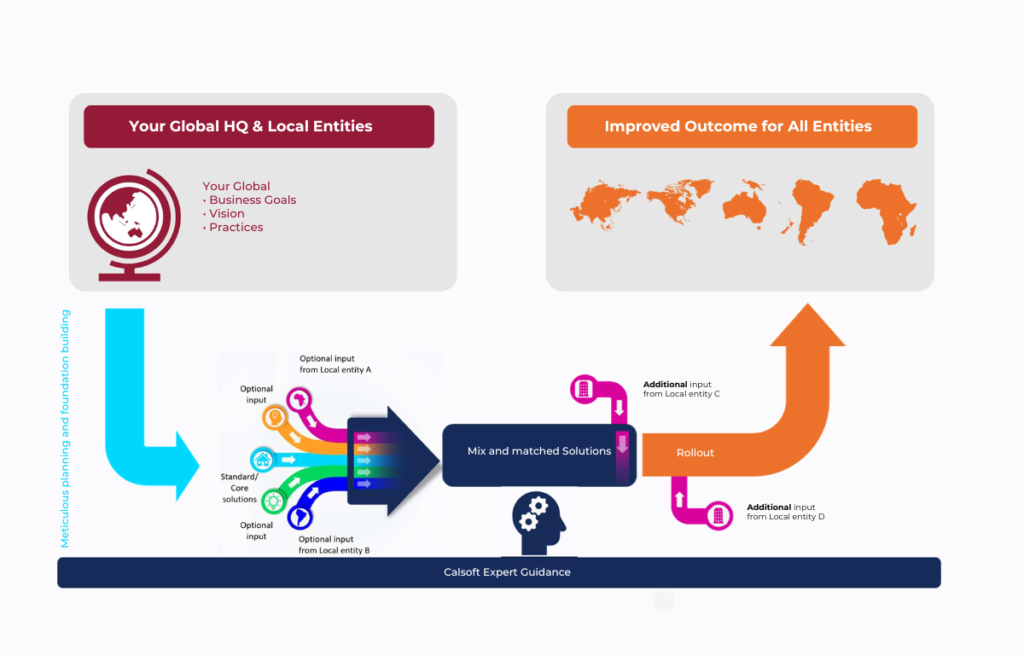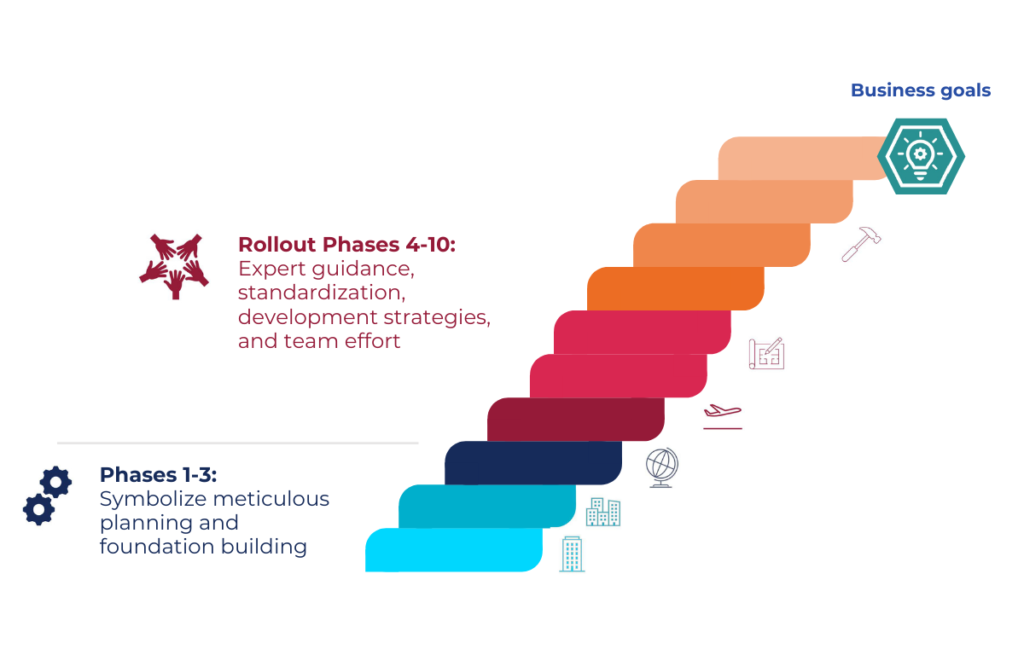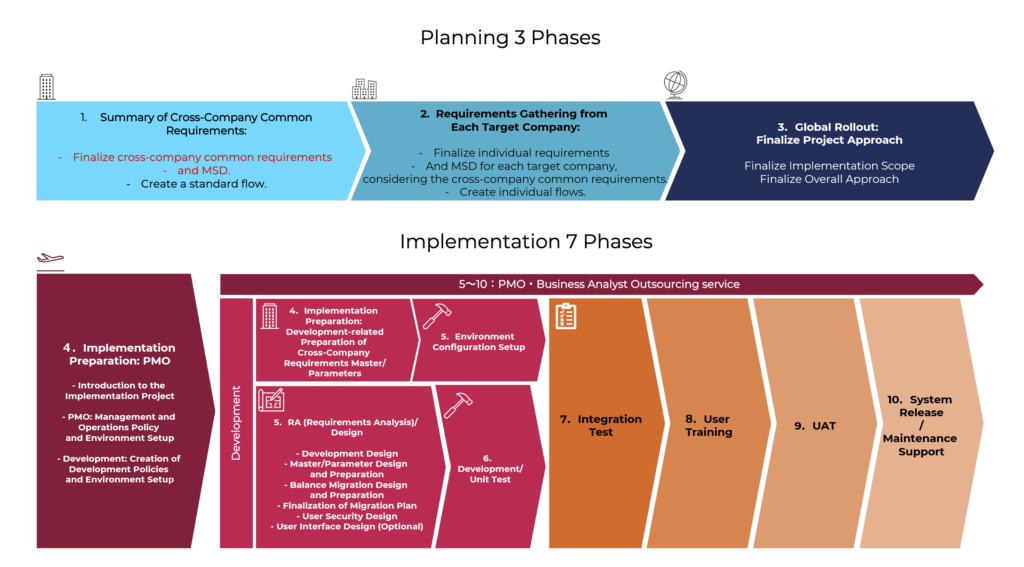

Phone
888-838-8422

Address
19701 Hamilton Ave.
Torrance, CA 90502

info@calsoft.com
Drive Worldwide Growth With a Global ERP System Tailored To Your Business
Calsoft Systems’ ERP Global template service offers comprehensive and guided solutions to empower businesses to streamline current operations and achieve their objectives efficiently.
Through a meticulous understanding of your
- Business Goals
- ERP project objectives
- Technical requirements
and the unique characteristics of both headquarters and each global entity, Calsoft ensures a successful implementation.
Our approach to ERP implementation is comprehensive, encompassing 10 distinct phases. The first three phases emphasize careful planning, offering flexibility through a mix-and-match process to create a solid foundation for success.
As we progress to phases 4 to 10, we transition from planning to action, guided by experts, standardized processes, and refined strategies. Our focus remains on maintaining quality and minimizing risk.
Drawing on our experience, we fine-tune operations to ensure an efficient and effective global ERP implementation.
As part of our commitment to business consultation, Calsoft goes beyond establishing a proven ERP global template based on industrial best practices.
For example, by identifying superior practices among global subsidiaries, we dynamically enhance overall operational standardization, benefiting headquarters and branch levels alike.
With prestigious recognition as a Microsoft Partner of the Year and extensive ERP implementation experience across various industries.
Calsoft’s global template service empowers businesses focused on:
- Wholesale Trade
- Transportation and Warehousing
- Manufacturing
- Professional Services
to achieve their objectives and efficiently deploy global ERP systems.

Key Benefits of ERP Global Template Services

Tailored Solutions
The Calsoft ERP global template service provides customized solutions tailored to specific business goals, ensuring a comprehensive understanding of objectives and technical requirements for a successful global ERP implementation.

Expert Guidance
Clients benefit from Calsoft’s expertise, which includes expert guidance in designing operations, proven global rollout schemes with established templates, and application of industrial best practices, resulting in standardized and efficient operations.

Improved Outcome
Global ERP systems increase project success rates. Implementation risks are lower. Future reworks are less likely to occur. Streamlined and cost-effective ERP deployments align company objectives to enhance overall performance.
Business Goals You Can Achieve
Implementing Calsoft’s ERP Global Templates results in a unified and meticulously structured item master data system. They seamlessly integrate across subsidiary companies and the headquarters. Rule enforcement, management guidelines, and consistent naming conventions eliminate conflicts between entities.
Additionally, global ERP systems enable management of critical components. The Chart of Accounts (COA), Customer Master, and Vendor Master can be integrated. The risk of conflicts is eliminated.
This holistic approach leads to streamlined operations, accelerated financial report closures, real-time inventory visibility, standardized approval workflows, cohesive data analysis, and enhanced compliance efforts.
The result is heightened efficiency and an overall improvement in business performance, making Calsoft’s Global Templates a vital asset for your organization.

Accelerating Financial Data Closure

Integrated Master Data

Improved Compliance

Improved Visibility

Standardization & Approval Flow

Common Axes of Analysis
Evaluating Our Global ERP Roll-out Template Service for Your Company
Experience Game-Changing Benefits

Cost Reduction
Slash your expenses and boost profitability

Enhanced Performance Analysis
Elevate your business insights to new heights

Improved Risk Management
Enhance your compliance and fortify risk management

Optimize Inventory Management
Streamline your inventory for optimal efficiency

Data-Driven Decisions
Empower your team with insightful analysis

Financial Report Consolidation
Unifying financial data for informed decision-making
Tailored Solutions for Global ERP Challenges
Our service is designed to meet the unique needs of top executives, including CEOs, COOs, CTOs, CFOs, and global company management. Global ERP system implementations are complex. We specialize in this field to tackle every scenario you can imagine.
Calsoft’s ERP global templates, forged through years of experience, ensure high-quality and efficient deployment within diverse organizations. With our assistance, IT managers and project leaders gain invaluable resources and guidance to navigate potential challenges with ease.
Drawing from our extensive ERP journey, we’ve cultivated practical insights to offer and empower your business further.

10 Phases of the Global Template Services
Global ERP implementation follows a well-structured approach comprising several key phases. Phase 1 involves understanding the customer’s business goals and decision criteria, while Phase 2 focuses on incorporating local requirements and clarifying the implementation of Microsoft Dynamics (MSD).
Drawing on past experiences, Phase 3 develops a pragmatic implementation plan, and Phase 4 provides PMO support for consistent management, designing policies to streamline operations. The creation of standard requirement masters/parameters further enhances deployment quality.
Phases 5 to 10 optimize development and establish a document library for better organization. Implementation of policies and parameters ensures both quality and cost reduction.
Integrated testing, user training, and support lead to enhanced management, while Phase 10 involves a comprehensive release plan and ongoing support, contributing to the global ERP system’s overall success and sustainability.

The global ERP project comprises 10 essential phases, designed to ensure success. While all phases are crucial, the first two are particularly pivotal.
Phase 1: Define Objectives
- Understand customer goals and expectations.
- Clarify decision criteria.
- Create standardized requirements.
- Visualize future processes.
- Consider MSD functionalities for risk mitigation.
Phase 2: Incorporate Local Requirements
- Gather local input for tailored operations.
- Maintain system standardization.
- Ensure project objectives are met.
- Enhance compliance, risk management, and cost reduction.
- Focus on process optimization and business performance.
Phase 3: Realistic Plan
- Utilize past ERP project experiences.
- Optimized development.
- Cost reduction through planning and standardization.
- Tailored solutions and alignment with best practices.
- Proven rollout schemes and templates.
- Standardized parameters and policies.
Phase 4: Project Management Support
- PMO support for consistent project management.
- Design policies for efficient operations.
- Create standard requirement masters/parameters.
- Phases 5-10: Development Optimization
- Establish a document library for better organization.
- Implement policies and parameters.
- Integrated testing.
- Comprehensive user training.
- Ongoing support for issue resolution.
Phases 5-10: Development Optimization
- Establish a document library for better organization.
- Implement policies and parameters.
- Integrated testing, user training, and support.

Accelerate your business with our ERP Global Templates.
After guiding you through strategic planning, phased implementation, and global standardization, the journey concludes with a support structure designed for continued success.
Our ERP Global Template unifies data and streamlines workflows while establishing a foundation that adapts as your business expands.
With deep expertise, long-term local and global support, and a culture rooted in collaboration, we provide a trusted, consistent partnership. Schedule an ERP consultation today!
FAQs
Companies gain unified oversight when operations across borders feed into a single platform. Such systems bridge disparate workflows, linking departments through a centralized database built to accommodate varying currencies, tax codes, and languages.
Collaboration becomes smoother as teams worldwide access consistent data and localized configurations adapt to regional needs. This approach supports harmonized reporting and process alignment, ensuring that global operations run in sync while accommodating local requirements.
Organizations typically select from three deployment models to match their infrastructure and strategy. One option keeps all components onsite on the company’s own servers. A second model operates through a provider’s internet-based platform with subscription access and remote maintenance.
The third combines both, allowing core workflows to remain local while leveraging cloud components for flexibility and scalability. Each approach addresses priorities — whether control, cost, or adaptability.
Managing back-office workflows—like supply chain, HR, accounting, and operations—falls under one category of systems. In contrast, another type focuses on nurturing customer relationships by tracking interactions, sales leads, and service issues.
While they serve different parts of the organization, linking them can reduce data silos and provide teams with a richer picture, from internal processes to client needs.
